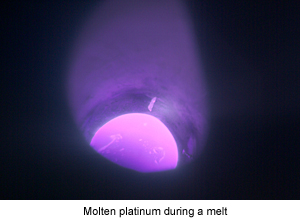Platinum for Wedding and Engagement Rings
Platinum is considered to be the "most precious" of the precious metals, and is your metal of choice, when only the best will do, and is also the choice of jewelry designers of fine heirloom quality jewelry.
Purity
Platinum is usually 90-95% pure. (We use a 950 Platinum alloy, where the other 5% is ruthenium.) White gold does appear slightly yellowish as it loses its polish and most commercial white gold is plated and will turn yellowish as the plating wears off. Platinum is always a cold light gray, and will retain its polish longer.
Rarity
Platinum is more scarce than gold. The annual supply of platinum is only about 130 tons, which is only 6% (by weight) of the total Western World's annual mine production of gold.
Durability
Platinum does not wear down as gold does, so, over the course of a lifetime, your ring will remain virtually the same weight and size. Subsequently, platinum holds diamonds and gemstones more securely. It can be cherished for generations. Also, platinum is very unlikely to crack or be brittle during any sizing (or repair) operations.
More Platinum Statistics
 Due to the unusual characteristics of this metal, a platinum smith must have a different set of tools than a goldsmith. For instance, platinum melts at 3225 degrees Fahrenheit, compared to fine gold which melts at 1945.
Due to the unusual characteristics of this metal, a platinum smith must have a different set of tools than a goldsmith. For instance, platinum melts at 3225 degrees Fahrenheit, compared to fine gold which melts at 1945.- Approximately 10 tons of ore must be mined to produce one ounce of pure platinum. Furthermore, the total extraction process takes six months.
- All of the platinum ever mined throughout history would fill a room of less than 25 by 25 by 25 feet.
- Platinum is heavier than gold, 11% more dense. One cubic foot weighs around 1,330 pounds.
- Platinum has many more industrial uses than either silver or gold. In fact more than 50% of the yearly production is consumed (read destroyed) by industrial uses.
- Also unlike gold, there are no large inventories of above-ground platinum. Therefore, any breakdown in the two major supply sources would catapult the price into orbit.
Historical Trivia
Platinum evokes the future through the cool gray color and technological uses, but it also recalls the past. In the 1890's the Louis Cartier introduced the metal as a setting, and made it part of his most exquisite creations for kings and millionaires. During the first 40 years of the twentieth century, platinum was the preferred metal for wedding and engagement rings and was almost always used to enhance the beauty of diamonds and other gemstones. However, for the duration of World War II, platinum was declared a strategic material and its use in most non-military applications was prohibited.
